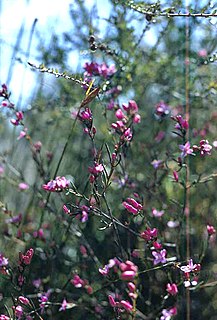
Cyanothamnus nanus, commonly known as the dwarf boronia or small boronia is a plant in the citrus family Rutaceae and is endemic to eastern Australia. It is a prostrate or low spreading shrub with simple or three-part leaves and white or pale pink four-petalled flowers.

Cyanothamnus baeckeaceus is a plant in the citrus family, Rutaceae and is endemic to eastern Australia. It is a slender or straggling shrub with simple or trifoliate leaves and pink and white four-petalled flowers. It is endemic to the south-west of Western Australia.

Boronia barkeriana, commonly known as Barker's boronia, is a plant in the citrus family, Rutaceae and is endemic to eastern Australia. It is a shrub with ground-hugging branches, simple, toothed leaves and bright pink, four-petalled flowers.

Cyanothamnus coerulescens, commonly known as blue boronia, is a plant in the citrus family, Rutaceae and is endemic to southern Australia. It is a small, spindly shrub with glandular stems, small, more or less cylindrical leaves and blue to pinkish mauve, four-petalled flowers. There are two subspecies endemic to Western Australia and a third that also occurs in three eastern states.

Boronia filifolia, commonly known as the slender boronia, is a plant in the citrus family Rutaceae and is endemic to south-eastern Australia. It is a slender shrub with simple or pinnate leaves and pale to deep pink four-petalled flowers.

Boronia gracilipes, commonly known as karri boronia, is a plant in the citrus family, Rutaceae and is endemic to the south-west of Western Australia. It is an erect, spindly shrub with compound leaves and pink, four-petalled flowers.

Boronia grandisepala is a plant in the citrus family Rutaceae and is endemic to northern parts of the Northern Territory. It is an erect shrub with elliptic leaves and white, pink or burgundy-coloured, four-petalled flowers.

Boronia heterophylla, commonly known as red boronia or Kalgan boronia, is a plant in the citrus family Rutaceae, and is endemic to the south-west of Western Australia. It is an erect, slender shrub with trifoliate leaves and deep pink to red, four-petalled flowers arranged singly in leaf axils.

Boronia lanceolata is a plant in the citrus family Rutaceae and is endemic to northern parts of the Northern Territory and Queensland. It is an erect shrub with many branches, elliptic to lance-shaped leaves and white or pink, four-petalled flowers. It is the most common boronia in the Northern Territory.

Cyanothamnus occidentalis, commonly known as the rock boronia, is a plant in the citrus family Rutaceae and is endemic to eastern Australia. It is an erect, woody shrub with pinnate or bipinnate leaves and groups of up to three white to pale pink, pink four-petalled flowers arranged in leaf axils.

Boronia bowmanii is a plant in the citrus family, Rutaceae and is endemic to Queensland. It is an erect shrub with pinnate leaves and four-petalled flowers.

Cyanothamnus defoliatus is a plant in the citrus family, Rutaceae and is endemic to the south-west of Western Australia. It is a straggly shrub with simple, thread-like leaves and white to pink, four-petalled flowers that are pale blue on the back.

Cyanothamnus fabianoides is a plant in the citrus family, Rutaceae and is endemic to the south-west of Western Australia. It is a compact shrub with many branches, simple, more or less cylindrical leaves and single white, pink or pale blue four-petalled flowers in the leaf axils.

Cyanothamnus inconspicuus is a plant in the citrus family, Rutaceae and is endemic to the south-west of Western Australia. It is a shrub with pinnate leaves and small white or creamy green flowers with four petals and eight stamens and occurs from the Stirling Range to Mount Ragged.

Boronia nematophylla is a plant in the citrus family Rutaceae and is endemic to the south-west of Western Australia. It is a shrub with thin, simple leaves and pale red to purple, four-petalled flowers arranged singly or in small groups in leaf axils.

Cyanothamnus penicillatus is a plant in the citrus family, Rutaceae and is endemic to the south-west of Western Australia. It is a low, spreading shrub with pinnate leaves and white flowers with four petals and eight stamens.

Cyanothamnus polygalifolius, commonly known as dwarf boronia, milkwort-leaved boronia or milkwort boronia, is a plant in the citrus family Rutaceae and is endemic to eastern Australia. It is a low-lying shrub with simple leaves and white or pink flowers arranged singly or in groups of up to three in leaf axils.

Cyanothamnus subsessilis is a species of plant in the citrus family, Rutaceae and is endemic to the south-west of Western Australia. It is a woody, mostly glabrous shrub with simple leaves and flowers with four petals that are white on the front and green to blue on the back.

Cyanothamnus tenuis, commonly known as blue boronia, is a species of plant in the citrus family, Rutaceae, and is endemic to the southwest of Western Australia. It is a slender shrub with thread-like, sessile leaves, and flowers with four petals that are white to pink on the front and pale blue on the back.

Cyanothamnus westringioides is a species of erect shrub that is endemic to a small area in the southwest of Western Australia. It has simple, narrow, sessile leaves and pale pink flowers arranged singly in leaf axils.





















